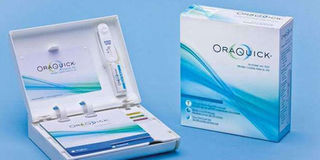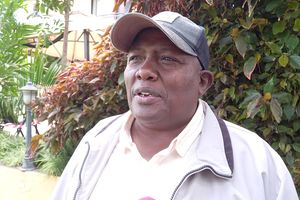Premium
Scientists compare success of HIV self-test types

OraQuick HIV self-test. FILE PHOTO | NATION MEDIA GROUP
What you need to know:
- Lodwar Referral Hospital chief executive officer, said the blood kit should be given more prominence to avoid inaccurate results.
- The swabbed saliva sample is placed in a solution that comes with the kit and gives the results in 20 minutes.
Self-testing for HIV using blood kits gives more accurate results than an oral fluid test, a study has shown.
This, the study revealed, could be because of the low quantity of HIV antibodies in oral fluid compared with blood.
The two HIV self-testing kits were launched in Kenya mid last year at a time the country was scaling up the fight against HIV/Aids.
HIV self-testing involves an individuals collecting their specimen and conducting a test to interpret their own test results.
RESULTS
The two kits were introduced together with Pre-exposure prophylaxis, or PrEP, a pill for HIV-negative people who are at substantial risk of getting it to prevent infection, making Kenya among the first countries in the world to introduce the kits.
They come in two forms. The first is an oral kit, OraQuick, which requires the user to do a 360 degrees swab of the upper and lower mouth gums using a collection kit.
The swabbed saliva sample is placed in a solution that comes with the kit and gives the results in 20 minutes.
The second is a blood sample kit known as Insti, which involves pricking the finger for blood that is then put on the kit.
The results are ready in one minute, and the study says they are more accurate.
The HIV self-test kits are available for between Sh700 and Sh800 in selected pharmacies.
RECOMMENDATIONS
Nearly 500,000 Kenyans are infected with HIV and should be on antiretroviral (ARV) treatment but do not know their status, data from the Ministry of Health shows.
Kenyans above 15 years can purchase, perform the HIV test and interpret the results on their own and at their convenience.
The study also revealed that self-testers are able to perform HIV tests and interpret the results as accurately as health workers would do.
The analysis, published in The Lancet HIV, assessed the reliability and performance of HIV rapid diagnostic tests carried out by self-testers compared with trained healthcare workers.
The review, which will be used to inform World Health Organization (WHO) recommendations on HIV self-testing, assessed 25 studies with sample sizes of between 22 and 5,662 participants, carried out in a diverse range of countries between 1995 and 2016.
COMPETENCE
Dr Carmen Figueroa of the Department of HIV at WHO and lead author of the study, said the HIV self-testing approach has increased access to HIV testing.
“As a discreet and convenient approach, HIV self-testing might be most useful in reaching people who are reluctant or unable to access existing HIV testing services because of concerns about privacy, stigma, discrimination, and, in some contexts, criminalisation.
"But if the kits are not used well or not accurately, we will be having invalid results instead of valid and vice versa,” she said.
She adds: “Various studies have revealed that HIV self-testing is highly acceptable among many different population groups, including those with low testing coverage and who report barriers to and low uptake of existing HIV testing services.
"Despite this, some policymakers and users have raised concerns that self-testers might not be able to do the test or interpret the test results correctly.”
Dr Gilchrist Lokoel, Lodwar Referral Hospital chief executive officer, said the blood kit should be given more prominence to avoid inaccurate results.
“The two are different. When we talk about blood and saliva, the percentage of HIV antibodies in the two areas (is) different, hence you may get an invalid result when you use saliva and get a valid result when you use blood,” he said
INSTRUCTIONS
The review includes 13 studies assessing unassisted HIV self-testing (where people carried out self-testing following manufacturers’ instructions included in the kit), 11 studies relating to directly assisted HIV self-testing (where people receive a demonstration of how to do the test or interpret the test result before carrying out the test themselves), and one study reported on both approaches.
The majority of studies (15 in total) used oral fluid-based rapid diagnostic tests, six used blood-based rapid diagnostic tests, and four used both.
In the systematic review and meta-analysis, researchers searched several publications for observational and experimental studies reporting on HIV self-testing performance.
From the findings, it found out that from both the methods, invalid results were mainly because of user error and errors from manufacturers.
The study recommends that diagnostic tests for self-testing should contain simple instructions for use and patients be provided with additional support such as instructional videos.
“Errors in performance might be reduced through the improvement of rapid diagnostic tests for self-testing, particularly to make sample collection easier and to simplify instructions for use,” the study said.





